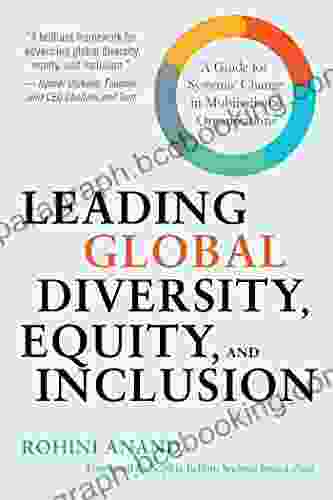Empowering Transformation: A Comprehensive Guide for Systemic Change in Multinational Organizations

In an era characterized by rapid globalization and unprecedented technological advancements, multinational organizations (MNOs) face the imperative to adapt and evolve continuously. Systemic change has emerged as a crucial strategy for MNOs seeking to navigate these dynamic and complex landscapes. This comprehensive guide serves as an invaluable resource for leaders and change agents within MNOs, providing a roadmap for successful and sustainable systemic transformation.
Systemic change encompasses the profound alteration of an organization's fundamental structures, processes, and culture. It involves a holistic approach that addresses multiple levels of the organization, from individual behaviors to organizational policies and practices. The goal of systemic change is to create an organization that is adaptable, resilient, and capable of thriving in the face of constant disruption.
Successful systemic change in MNOs relies on a foundation of core principles:
4.9 out of 5
| Language | : | English |
| File size | : | 5404 KB |
| Text-to-Speech | : | Enabled |
| Enhanced typesetting | : | Enabled |
| X-Ray | : | Enabled |
| Word Wise | : | Enabled |
| Print length | : | 288 pages |
| Screen Reader | : | Supported |
- Embrace Complexity: MNOs operate in intricate and interconnected environments. Systemic change requires an understanding of the organization's complexity and interconnectedness.
- Engage Stakeholders: Change initiatives should involve all levels of the organization, including employees, customers, suppliers, and partners. Active engagement fosters buy-in and ensures that diverse perspectives are considered.
- Focus on Outcomes: Define specific and measurable outcomes for the change initiative. This provides a clear direction and allows for progress tracking.
- Create a Culture of Innovation: Encourage experimentation and risk-taking to foster a culture that embraces change and innovation.
- Foster Collaboration: Cross-functional collaboration and teamwork are essential for effective systemic change. Break down silos and promote open communication channels.
The implementation of systemic change in MNOs involves a structured and iterative process:
- Assessment and Diagnosis: Conduct a thorough assessment of the organization's current state, identifying areas for improvement and opportunities for change.
- Vision and Strategy Development: Define a clear vision for the desired future state and develop a comprehensive strategy for achieving it.
- Change Plan Design: Create a detailed plan that outlines specific interventions, timelines, and resources required for the change initiative.
- Implementation and Execution: Roll out the change plan in a phased and systematic manner, monitoring progress and making adjustments as needed.
- Evaluation and Refinement: Regularly evaluate the impact of the change initiative and make necessary refinements to ensure its effectiveness and sustainability.
Numerous MNOs have successfully implemented systemic change initiatives, reaping significant benefits. Here are two notable examples:
- Nestlé: The food giant underwent a comprehensive transformation, focusing on sustainability, responsible sourcing, and innovation. It introduced a new "Creating Shared Value" framework, aligning business goals with societal and environmental objectives.
- IBM: IBM embarked on a bold reorganization to become a more agile and client-centric organization. It created multiple "businesses" within the company, each responsible for its own bottom line and strategy.
A range of tools and techniques can support MNOs in implementing systemic change:
- Systems Thinking: A framework for understanding the interconnectedness and complexity of organizations, enabling the identification of leverage points for change.
- Design Thinking: A human-centric approach to problem-solving that emphasizes empathy, experimentation, and iteration.
- Agile Methodologies: Iterative and flexible approaches to project management that facilitate rapid development, testing, and feedback.
- Change Management Tools: Models and frameworks that guide organizations through the different stages of change, such as the Lewin's Change Model and the Kotter's 8-Step Process.
Systemic change in MNOs is not without challenges. Resistance to change is a common obstacle that can arise from various sources. To overcome resistance, consider the following strategies:
- Build a Strong Coalition: Develop a group of influential leaders who support the change initiative and advocate for its success.
- Communicate Effectively: Clearly communicate the rationale for change, outlining the benefits and addressing concerns.
- Empower Employees: Engage employees in the change process, providing them with opportunities to contribute and take ownership.
- Create a Sense of Urgency: Highlight the importance of the change initiative and the potential consequences of inaction.
Systemic change is essential for multinational organizations to thrive in today's dynamic and competitive environment. By embracing the principles, steps, and tools outlined in this guide, MNOs can successfully navigate the challenges of change and emerge as agile, resilient, and future-ready organizations. Remember, systemic change is an ongoing journey, requiring continuous learning, adaptation, and a relentless commitment to improvement.
4.9 out of 5
| Language | : | English |
| File size | : | 5404 KB |
| Text-to-Speech | : | Enabled |
| Enhanced typesetting | : | Enabled |
| X-Ray | : | Enabled |
| Word Wise | : | Enabled |
| Print length | : | 288 pages |
| Screen Reader | : | Supported |
Do you want to contribute by writing guest posts on this blog?
Please contact us and send us a resume of previous articles that you have written.
 Book
Book Novel
Novel Page
Page Chapter
Chapter Text
Text Story
Story Genre
Genre Reader
Reader Library
Library Paperback
Paperback E-book
E-book Magazine
Magazine Newspaper
Newspaper Paragraph
Paragraph Sentence
Sentence Bookmark
Bookmark Shelf
Shelf Glossary
Glossary Bibliography
Bibliography Foreword
Foreword Preface
Preface Synopsis
Synopsis Annotation
Annotation Footnote
Footnote Manuscript
Manuscript Scroll
Scroll Codex
Codex Tome
Tome Bestseller
Bestseller Classics
Classics Library card
Library card Narrative
Narrative Biography
Biography Autobiography
Autobiography Memoir
Memoir Reference
Reference Encyclopedia
Encyclopedia Neal Pollack
Neal Pollack Joseph Marshall
Joseph Marshall Jon Ronson
Jon Ronson Jonah Salz
Jonah Salz Joshua Straub
Joshua Straub Ken Schwaber
Ken Schwaber Jonathan White
Jonathan White John Otis
John Otis Joseph Truitt
Joseph Truitt Tiara Mcclure
Tiara Mcclure Nolan Clark
Nolan Clark Shahid Nawaz
Shahid Nawaz John Mcenroe
John Mcenroe John Micklethwait
John Micklethwait Joseph Vaughn
Joseph Vaughn John Michael Kelly
John Michael Kelly Margery Cuyler
Margery Cuyler Lesley Poling Kempes
Lesley Poling Kempes Jonathan Downie
Jonathan Downie Jory Fleming
Jory Fleming
Light bulbAdvertise smarter! Our strategic ad space ensures maximum exposure. Reserve your spot today!

 Ralph Waldo EmersonMao's Last Dancer: The True Story That Inspired the Major Motion Picture
Ralph Waldo EmersonMao's Last Dancer: The True Story That Inspired the Major Motion Picture
 Edwin CoxUncover the Profound Wisdom of the Rabbi for Uncharted Times: Life Lessons of...
Edwin CoxUncover the Profound Wisdom of the Rabbi for Uncharted Times: Life Lessons of...
 Derrick HughesElevate Your Sports Obsession with the Ultimate Guide: Sports Hit Home Run...
Derrick HughesElevate Your Sports Obsession with the Ultimate Guide: Sports Hit Home Run... Hugh BellFollow ·3.5k
Hugh BellFollow ·3.5k Darnell MitchellFollow ·16.1k
Darnell MitchellFollow ·16.1k Francisco CoxFollow ·16.5k
Francisco CoxFollow ·16.5k Max TurnerFollow ·13.1k
Max TurnerFollow ·13.1k Duane KellyFollow ·11.6k
Duane KellyFollow ·11.6k Arthur C. ClarkeFollow ·3.1k
Arthur C. ClarkeFollow ·3.1k Emilio CoxFollow ·4.3k
Emilio CoxFollow ·4.3k Edward ReedFollow ·19.2k
Edward ReedFollow ·19.2k

 Joseph Foster
Joseph FosterUnravel the Enigmatic Murders in "Pride and...
Dive into a World...

 Jeffery Bell
Jeffery BellTrauma-Focused CBT for Children and Adolescents: The...
Trauma is a...

 Jorge Luis Borges
Jorge Luis BorgesSense and Second Degree Murder: A Jane Austen Murder...
Prepare yourself for a...

 Chase Simmons
Chase SimmonsUnleash the Vibrant World of Watercolor: An Enchanting...
In the world of art, watercolor painting...

 Rubén Darío
Rubén DaríoAmerican Funny Animal Comics In The 20th Century: A...
Step into a bygone era of laughter and...
4.9 out of 5
| Language | : | English |
| File size | : | 5404 KB |
| Text-to-Speech | : | Enabled |
| Enhanced typesetting | : | Enabled |
| X-Ray | : | Enabled |
| Word Wise | : | Enabled |
| Print length | : | 288 pages |
| Screen Reader | : | Supported |








